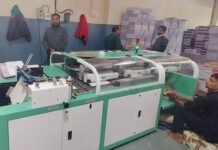
The Printers House has been manufacturing web offset presses since 1975. Last year, Rishab Kohli, the third generation of the promoter family, took over TPH as its hands-on director. He has won exciting export and domestic newspaper and book printing orders with his drive to build a customer-focused company. The young director restored the company to its industry-dominant position and kept the factory in Ballabgarh in the Delhi-NCR, humming in the past year, despite the pandemic.
I had hoped this meeting would happen in any of the several years before the pandemic because from time to time, there were hints that it would. Like many of the TPH employees, customers, and well-wishers, I have been waiting for Rishab Kohli to return from America and run the company. Kohli is the third generation of a family that first sold and then manufactured for 45 years, single-width single-circumference web offset presses. Since Rishab Kohli’s father Mohan Kohli fell ill several years ago, there has been a bit of uncertainty about the company that needed to be settled.
Kohli is only 28 years old, I believe I heard him say at one point, but I thought it disrespectful to ask his age – especially as I was meeting him for the first time. After his education and a brief but successful career as a startup entrepreneur – in the last year, he returned to India. As a student in the US, he benefited from the family’s association with Goss and counts Goss veteran Al Taber as a mentor. Taber, who was associated with The Printers House when it sold Goss Community presses, took young Kohli under his wing – showing him around the company’s New Hampshire factory and trained him to run a Community press.
Customers wanted TPH to be strong
Several newspaper owner customers in India urged Rishab Kohli to come back and take over the family company, and he has now been on it since February of 2020, managing operations along with a professional board of directors. He began by talking to customers, and since the company has a large footprint in the market, this was not too difficult. He believes in the value of print, in the role of newspapers and an informed public, and in the need for web offset printing presses in the foreseeable future. “We became customer-centric,” he says. “I told the team that if we focus on helping the customers, the orders will come.”
He says that Wan-Ifra data told him that 86% of newspaper revenues were coming from print globally, and in India, the figure was even higher at 93%. He listened to his customers, realizing that many needed support during the pandemic and the digital transition. He listened to his bigger customers who wanted improvement of the machines, but as usual, were mostly unwilling to pay more. He acknowledged that the presses’ quality had to be improved, and some components needed re-engineering, such as the automatic reel changer (ARC).
A better press at the same or lower cost
Kohli says he improved the materials of the components that were going into the presses, and in a market that at first seemed stagnant, he tried to reduce the machine’s cost. Or, at the very minimum, to reduce the cost of running 36,000 copies an hour presses by seeing how he could help his customers reduce their wastage. Very confident of its 30,000 and 36,000 copies an hour presses, TPH was able to sell several book presses consisting of a single 4-Hi tower and folder with a quarter folder. The company convinced customers of the savings they could effect by simply installing narrow gap cylinders.
Kohli says he dipped into the company’s reserves and kept on every shop floor employee – and as the market responded to his helping the customer focus, the factory started humming in near-normal shifts. Even with the low demand of the lockdown and the pandemic constraints, the company was able to sell and export several presses.

Exports to Nepal and Myanmar – a new daily in Orissa
During the pandemic and despite several challenges, TPH sold and installed newspaper presses last year, including one in Nepal. The Printers House team sold and exported another newspaper press to Myanmar. The Myanmar press is a highly automated shaftless 36,000 copies an hour press with ARCs, remote inking, and registration using QI systems components.
Kohli tells us that the Printers House’s most exciting deal this year has been to a newspaper startup in Orissa to The Sakala. The new Odia daily has purchased a significant number of TPH Orient 4-Hi towers rated at 36,000 copies an hour. The press lines are being installed in four centers across the state.
Rishab Kohli seems to have brought The Printers House back to walking and talking life. He has done this in a very challenging situation for the newspaper and book industry and the country’s economy. The company always had strengths – it was a structured engineering company. It believed in standard components and consistency, and because of its volumes, it maintained a manufacturing program. The third-generation heir and director is, so far, more than one could have hoped for. He is a confident professional, a self-confessed salesman of a very high order – convinced that his company is the best manufacturer of 36,000 copies an hour web offset presses in the world.
Like his grandfather and father, the young man believes in print and that in the future growth of the country, information and knowledge are of value. That regional and small newspapers and local news are still needed. He is not unaware of the challenges, but one only wishes that some of his customers had the same self-belief that he has.
This article has been slightly edited by the author on 22 January 2021 and again on 23 January 2021.















